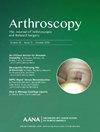对 45 岁及以上的活跃患者进行分期髋关节镜手术和髋臼周围截骨术,结果评分的改善程度与年轻患者相当。
IF 5.4
1区 医学
Q1 ORTHOPEDICS
Arthroscopy-The Journal of Arthroscopic and Related Surgery
Pub Date : 2024-11-07
DOI:10.1016/j.arthro.2024.10.039
引用次数: 0
摘要
目的:与年轻组相比,确定45岁及以上活跃患者分期髋关节镜和髋臼周围截骨术(PAO)的中期疗效:对2015年至2021年期间接受分期关节镜手术和PAO的所有年龄≥45岁的患者进行回顾性分析,并与病例匹配的年轻患者对照组进行比较。所有患者在手术前均接受了至少 6 个月的非手术治疗。在进行 PAO 之前,所有患者都接受了髋关节镜检查,以治疗关节内病变。实验组包括年龄大于 45 岁、无明显骨关节炎的发育不良患者,他们都接受了 PAO 手术,并报告了至少 1 年的术后 PROs。患者报告的结果(PROs)使用国际髋关节结果工具(iHOT-12)和非关节炎髋关节评分(NAHS)进行量化:研究对象包括35名患者(44个髋关节),平均年龄(49.4 ± 3.8)岁。外侧中心边缘角度从术前(20.1 ± 4.5 度)明显改善到术后(33.2 ± 3.2 度)(P0.05):结论:年龄≥45 岁的患者在接受分期髋关节镜和 PAO 术后,髋关节功能和疼痛均有明显改善,其结果评分与年轻患者相当。我们的研究结果表明,经过适当选择的无明显髋关节骨关节炎的老年发育不良患者在接受髋关节保留手术后,髋关节疼痛和功能会得到有临床意义的改善:III,回顾性比较病例系列。本文章由计算机程序翻译,如有差异,请以英文原文为准。
Staged Hip Arthroscopy and Periacetabular Osteotomy in Active Patients Aged 45 Years and Older Produce Comparable Improvements in Outcome Scores to Younger Patients
Purpose
To determine staged hip arthroscopy and periacetabular osteotomy (PAO) mid-term outcomes in active patients aged 45 years and older compared with a younger group.
Methods
All patients aged 45 years and older who underwent staged arthroscopy and PAO between 2015 and 2021 were retrospectively analyzed and compared with a case-matched control group of younger patients. All patients underwent at least 6 months of nonoperative management prior to surgery. Prior to PAO, all patients underwent hip arthroscopy to address any intra-articular pathology. The experimental group consisted of patients with dysplasia aged 45 years and older without significant osteoarthritis who underwent PAO and reported patient-reported outcomes for a minimum of 1 year postoperatively. Patient-reported outcomes were quantified using the International Hip Outcome Tool 12 (iHOT-12) score and Non-arthritic Hip Score (NAHS).
Results
The cohort consisted of 35 patients (44 hips) with a mean age of 49.4 ± 3.8 years. The lateral center-edge angle significantly improved from preoperatively (20.1° ± 4.5°) to postoperatively (33.2° ± 3.2°, P < .001). The mean follow-up period in the PAO cohort aged 45 years and older was 2.80 years (standard deviation, 1.3 years) postoperatively. Patients reported significant improvements in the iHOT-12 score (36.6 ± 14.1 preoperatively vs 81.2 ± 21.0 at latest follow-up, P < .001) and NAHS (59.2 ± 15.5 preoperatively vs 87.4 ± 13.1 at latest follow-up, P < .001). The older cohort did not report significantly different iHOT-12 scores compared with the control group at any point, and age did not significantly affect either outcome score (P > .05).
Conclusions
Patients aged 45 years and older reported a statistically significant improvement in hip function and pain after staged hip arthroscopy and PAO, with outcome scores comparable to a younger cohort. Our findings show that appropriately selected older patients with dysplasia without significant pre-existing hip osteoarthritis experience clinically meaningful improvements in hip pain and function after hip preservation surgery.
Level of Evidence
Level III, retrospective, comparative case series.
求助全文
通过发布文献求助,成功后即可免费获取论文全文。
去求助
来源期刊
CiteScore
9.30
自引率
17.00%
发文量
555
审稿时长
58 days
期刊介绍:
Nowhere is minimally invasive surgery explained better than in Arthroscopy, the leading peer-reviewed journal in the field. Every issue enables you to put into perspective the usefulness of the various emerging arthroscopic techniques. The advantages and disadvantages of these methods -- along with their applications in various situations -- are discussed in relation to their efficiency, efficacy and cost benefit. As a special incentive, paid subscribers also receive access to the journal expanded website.

 求助内容:
求助内容: 应助结果提醒方式:
应助结果提醒方式:


